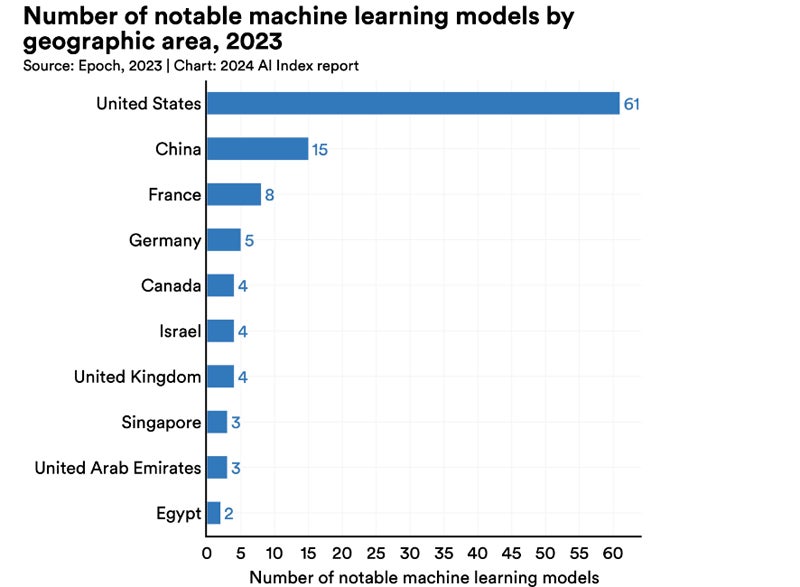Research conducted in 2023 by the Large European AI Models initiative found 73% of AI foundation models since 2017 were from the U.S. and 15% from China. It warned Germany was missing an AI “paradigm shift” that could “jeopardise Europe’s digital sovereignty.”
The AI foundation model dominance of the U.S. and China is leading to similar concerns in APAC countries. There are some fears this could impact citizens and enterprises in the region in areas including data security and governance, as well as geopolitical or supply chain risk.
Nation-states like Singapore, Japan and Australia are responding by developing or considering sovereign AI foundation models. For instance, Australia’s national science body, the Commonwealth Scientific and Industrial Research Organisation, recently released a paper asking if Australia should invest in its own foundation models.
Businesses could benefit from models that are more sensitive to the nuances of their culture or language and promise to keep data secure and compliant within their own country’s borders. Building sovereign AI models could also help develop local AI compute and skills ecosystems.
Download these Top 10 Artificial Intelligence Use Cases from TechRepublic Premium
US and China AI dominance spurring interest in sovereign AI
The dominance of the U.S. in AI continued throughout 2023. Stanford’s AI Index Report released in 2024 found 61 notable models had been released in the U.S. in 2023; this was ahead of China’s 15 new models and France, the biggest contributor from Europe with eight models (Figure A). The European Union as a whole produced 21 notable models, while Singapore, with three models, was the only other producer of notable large language models in APAC.
Figure A

US and China are creating many of today’s popular LLMs
Many LLMs used widely in APAC originate in the U.S., including OpenAI’s ChatGPT 3.5 and GPT-4, Meta’s Llama, Google Gemini, Anthropic’s Claude and Microsoft’s Copilot, as well as open-source models like BERT.
SEE: How the Australian Government Sees AI Accelerating Productivity
China is the biggest challenger to the U.S., with some companies using the open-source Llama 1 to train new LLMs. Notable models from China include Baidu’s ChatGPT-style Ernie Bot, which now has 200 million users, and an Alibaba-developed LLM tailored to Southeast Asian languages called SeaLLM.
Industry leaders focus discussion on sovereign AI capabilities
Key industry stakeholders are advocating for more sovereign AI. NVIDIA CEO Jensen Huang said during a recent World Governments Summit every country needed to “own the production of their own intelligence,” recommending they “codify their language, data and culture” into their own LLM.
As reported by Business Standard, IBM CEO Arvind Krishna said, “Every country ought to have sovereign capability on artificial intelligence, including large language models, and generative AI,” to “use it for purposes the rest of the world does not want to invest in, or that it may not want to expose to others.”
Foundation LLM market concentration has risks for businesses
Many enterprises in APAC are customising existing AI models and putting in place measures to protect IP from being sucked into offshore training models. However, the lack of sovereign AI models and the dominance of some nation-states expose businesses to risks.
In the CSIRO paper released in March 2024, key factors were noted that Australia should weigh when considering whether to build its own sovereign AI model; these factors also apply to other countries in the APAC region.
- Competitive markets and pricing: Businesses may end up relying on a small number of dominant AI model providers in offshore markets, with the power to set pricing for things such as API access. In April 2024, the U.K.’s Competition and Markets Authority flagged “real concerns” over an already existing interconnected web of 90 partnerships and strategic investments involving the same firms, namely Google, Apple, Microsoft, Meta, Amazon and NVIDIA.
- Reliability and stability: Reliance on privately owned LLMs exposes businesses to unexpected change. Two examples are OpenAI’s ousting and reinstatement of CEO Sam Altman or Twitter’s takeover by Elon Musk, which caused many institutional users to shift digital strategies.
- Cultural relevance and sensitivity: Asian countries are seeing the importance of having LLMs built from local datasets. This would ensure outputs integrate cultural norms and linguistic nuances or give correct advice on local laws, requirements and processes.
- Confidentiality, privacy and security of information: There are still concerns about private or sensitive data being fed into AI models offshore; this is holding public sector institutions back from fully embracing LLMs. Without adequately protecting data, an organisation’s IP could be at risk.
- Geopolitical risks: There is always the risk a major geopolitical event could put organisations or agencies at risk if they are reliant on offshore AI models. The CSIRO added that it is conceivable they could be used to influence public opinion of other sovereign nations.
- Ethics and content moderation: Ethics can be important to private organisations using different models. For example, OpenAI is the subject of several lawsuits over the training data used to build its models, leaving organisations potentially at risk should they use it.
Sovereign risk needs to be balanced with opportunities for businesses
The CSIRO said that while generative AI represents significant opportunities for businesses, “dependence on overseas (or private tech-corporation) made and operated AI foundation models also creates sovereign capability risks and concerns about fair and open markets for product development,” which countries and businesses would seek to avoid.
Asia-Pacific countries working on their own bespoke LLMs
Countries in APAC are considering the lack of sovereign AI capabilities. Singapore, Japan and Australia are already inviting discussions or implementing policies to begin the process of rebalancing the AI hegemony that exists in the global foundation model market.
Singapore
Singapore initiated a US $51 million (AUD $80 million) program, dubbed the National Multimodal LLM Programme (NMLP), to develop a base model with regional context that can understand the unique linguistic characteristics and multilingual environment.
The Infocomm Media Development Authority said it would build on the early outcomes of AI Singapore’s SEA-LION (Southeast Asian Languages in One Network) model, a smaller scale open-sourced LLM that is more representative of the region’s cultural context and languages.
When delivered, the IMDA said it would be Southeast Asia’s inaugural regional LLM. Models and use cases are expected to be available from the project within the next two years.
Japan
The Japanese Liberal Democratic Party recommended in early 2023 the nation “build and strengthen AI model development capabilities, including foundation models,” highlighting a desire for skills and expertise, datasets and computational resources for an AI ecosystem.
The government flagged a particular concern with compute resources. In September 2023, it was revealed Japan is partnering with firms including NEC, Fujitsu and SoftBank to develop its own LLMs like ChatGPT, which would be tailored to the intricacies of the Japanese language and culture.
Australia
The CSIRO paper canvassed a range of mitigating measures that could support a strengthened Australian position in the global AI order.
These included building the necessary computing infrastructure by securing high-performance AI accelerator chips, or GPUs, amid high global demand. The CSIRO also raised the possibility of identifying, validating and making available datasets for training AI foundation models and increasing workforce AI skills via training, education and improved access to talent pools.
SEE: How the CSIRO is boosting flatting AI investment in Australia via competition
In addition, the CSIRO asked whether Australia could negotiate bilateral or multilateral international collaborations to share AI expertise and resources or invest in building, fine tuning and applying sovereign AI foundation models to improve government functions, among other measures.
